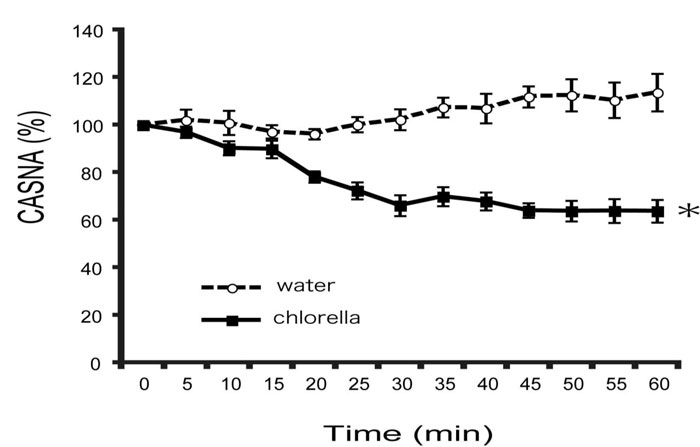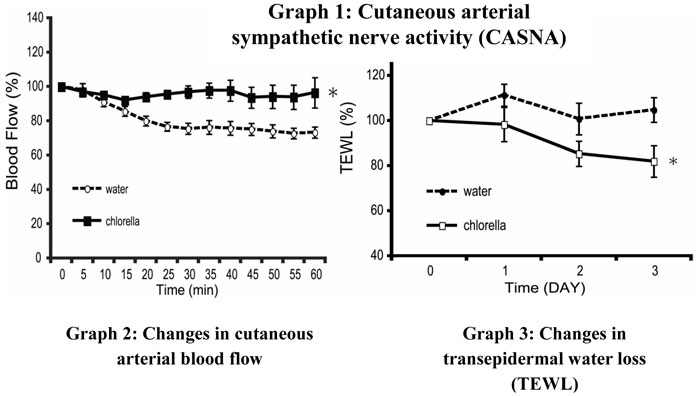- TOP
- List of reports
- Research results on the effects of Chlorella administration on cutaneous arterial sympathetic
nerve activity, cutaneous arterial blood flow, and transepidermal water loss were published in a scientific journal.
Research results on the effects of Chlorella administration on cutaneous arterial sympathetic nerve activity, cutaneous arterial blood flow, and transepidermal water loss were published in a scientific journal.
【Scientific information】
Research and Development Department, Sun Chlorella Corporation
Research results on the effects of Chlorella administration on cutaneous arterial sympathetic nerve activity, cutaneous arterial blood flow, and transepidermal water loss were published in a scientific journal.
Recently, results of studies that demonstrated the efficacy of Chlorella administration in rats, as summarized below, were published in a scientific journal.
- Objective
- We demonstrated in preliminary studies that Chlorella administration influences the activity of autonomic nervous systems. We focused this time specifically on the effects on cutaneous arterial sympathetic nerve and conducted a detailed investigation of them.
- Methods
- (1) Investigation of the effect on cutaneous arterial sympathetic nerve
One milliliter of Chlorella-powder suspension in water (30 mg/250 ml) was intraduodenally administered via a cannula in male Wistar rats weighing approximately 300 g (aged approximately 9 weeks), and changes in cutaneous arterial sympathetic nerve activity (CASNA) were measured electrophysiologically. Animals in the control group received 1 ml of water. - (2) Investigation of the effect on skin blood flow
One milliliter of Chlorella-powder suspension in water (30 mg/250 ml) was intraduodenally administered via a cannula in male Wistar rats weighing approximately 300 g (aged approximately 9 weeks), and changes in tail skin blood flow were measured with a laser blood flowmeter (ALF21, ADVANCE Co., Ltd., Tokyo, Japan). Animals in the control group received 1 ml of water. - (3) Investigation of the effect on transepidermal water loss
Changes in moisture at 2 sites of the back, which are located symmetrically across the vertebral column, were measured in male HWY hairless rats weighing approximately 300 g (aged approximately 8 weeks). Cutaneous water loss (transepidermal water loss [TEWL]) as an indicator of moisture was measured with VapoMeter (Delfin Technologies Ltd., Kuopio, Finland).With regard to drinking water, animals in the Chlorella group were provided only Chlorella suspension in water (30 mg/250 ml) at a concentration that was effective in experiments for measuring autonomic nervous activity ad libitum. Animals in the control group received water ad libitum.
- Results
- The study results showed that administration of Chlorella powder into the rat duodenum significantly reduces CASNA (Graph 1). Substances that reduce CASNA are reported to increase cutaneous arterial blood flow and moisturizing effect of the skin. Measurement of the effects of Chlorella administration on skin blood flow and TEWL in rats revealed, in fact, that the skin
blood flow is significantly increased and the TEWL is significantly reduced (Graph 2 and 3). In addition, these effects were found to be offset by administration of thioperamide maleate, a
histamine H3-receptor inhibitor.
These findings demonstrated that Chlorella administration reduces CASNA, increases cutaneous blood flow, promotes the supply of oxygen and nutrients, and enhances the water-retaining ability of the skin.
These results also suggested that the histaminergic nervous system in the brain and the suprachiasmatic nucleus (SCN) responsible for the biological clock play a role in the effects induced by Chlorella administration.


Details
- Name of meeting:
- Current Topics in Nutraceutical Research
- Title:
- Effects of chlorella pyrenidosa on cutaneous arterial sympathetic nerve activity, Cutaneous blood flow and transepidemial water loss in rats.
- Authors:
- Yuko Horii1), Tohru Mizoguchi2) , Yoshiyuki Fujisaki1), Katsuya Nagai1)3)
- Affiliation:
- 1) ANBAS Corporation, 2) Sun Chlorella corporation, 3) Osaka University





